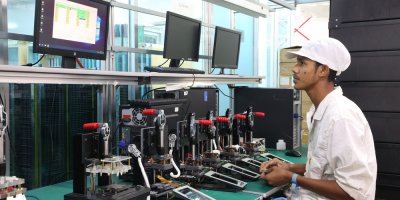
Advanced manufacturing technology is key to Australia’s growth. Source: Shutterstock
Technology brings new hope to Australia’s manufacturing sector
AUSTRALIA’S manufacturing sector has been a rising star for a decade starting 2002, rising sharply from US$41.6 billion to US$96.8 billion in 2008 to US$103.99 billion in 2012.
Since then, the industry has been on a slight downward trajectory, worrying economists, regulators, and businesses.
However, as organizations explore advanced manufacturing technology solutions in a bid to halt their decline and put themselves back on the growth path, they seem to create new opportunities and find more success.
An analysis of data from World Bank suggests that adopting of new technology has helped the country’s manufacturing sector — with the manufacturing industry contributing US$76.97 billion in 2017 and US$82.745 billion in 2018 to the country’s economy.
According to a new report by St. George Bank, the Australian manufacturing industry supports 1.27 million jobs in the country and advanced manufacturing technologies such as 3D printing, artificial intelligence (AI), robotics, materials engineering, and the internet of things (IoT) is changing the landscape completely.
“The manufacturing sector in Australia has seen positive growth over the past couple of years. That’s now the longest expansion in manufacturing in over a decade. It’s on the up-and-up right across the nation,” said Australia’s Advanced Manufacturing Growth Centre (AMGC) National Director – Industry Michael Sharpe.
“Australian companies have a potential global audience of more than seven billion customers, in addition to the 25 million here in Australia. Opportunities for smart companies who embrace new technologies have never been better. More manufacturers are looking at opportunities for export. That’s our future for Australia.”
St. George Bank’s Head of Manufacturing and Wholesale Matthew Kelly contributed significantly to the creation of the report. In his opinion, advanced manufacturing traits among organizations he deals with falls into three categories — knowledge, processes, and business models.
Kelly also notes that these businesses are also 73 percent more likely to use patents to protect their knowledge, 72 percent more likely to use automation to increase efficiencies and optimize resources, and 19 percent more likely to trade across geographic borders.
“It’s [manufacturing in Australia] a hive of innovation. I see this in the high-tech facilities that I visit, and I hear it from the smart manufacturers who are harnessing new technologies to move their business forward,” said Kelly.
Advanced manufacturing hinges on university collaborations
Australia doesn’t have all the talent it needs — especially when it comes to technology. Sure, there are plenty of migrant professionals specializing in technology but it is likely that they’re already gainfully employed and unavailable to support new projects that manufacturers in the country are exploring.
While the Australian government has created a new visa program for startups and other companies looking for technology professionals, businesses in the country also have the option of collaborating with universities — which is something many seem to like.
According to St. George Bank’s report, many manufacturers in the region pursuing advanced technology projects are collaborating with special divisions within universities to gain an edge.
The University of New South Wales (UNSW), for example, runs the Centre for Sustainable Materials Research and Technology (SMaRT). The unit is headed by Professor Veena Sahajwalla who works closely with manufacturers to develop building materials from old textiles, paper and glass, and high-quality 3D filament feedstock and other plastic products from electronic waste items.
Of course, one of the UNSW’s goals is to innovate in the sustainability space — which is something Sahajwalla incorporates into her work at SMaRT, as seen by the materials she uses.
“I’m finding that a simple conversation might just sow the seeds of some exciting new ideas, but the challenge is increasing connectivity to relevant stakeholders to achieve better supply chains and circular outcomes.
“The manufacturers I’m speaking to are very open to thinking about new opportunities coming down the pipeline and this is vital for long-term survival and sustainability,” explained Sahajwala.
The Australian government, the report highlighted, also works with open access innovation hubs such as Australia’s center for innovation in metallic additive manufacturing Lab22, where companies can access 3D printing technologies, and the Australian National Fabrication Facilities (ANFF).
Further, industry collaboration spaces such as FLEDGE Innovation Labs in the Macquarie Technology Corridor provide manufacturing companies with access to laboratory facilities and scientific equipment to help them experiment with advanced technologies and innovate for themselves.
All of these initiatives are supported by universities in some shape or form. The ANFF, for example, provides guidance to manufacturers and businesses by leveraging the academic intelligence of the 21 institutions at its core.
In the future, more manufacturing organizations will be exploring advanced technology solutions to innovate and create new opportunities for themselves. Australian manufacturing, St. George Bank’s report suggests, is just getting started on a new upward trajectory.
READ MORE
- Ethical AI: The renewed importance of safeguarding data and customer privacy in Generative AI applications
- How Japan balances AI-driven opportunities with cybersecurity needs
- Deploying SASE: Benchmarking your approach
- Insurance everywhere all at once: the digital transformation of the APAC insurance industry
- Google parent Alphabet eyes HubSpot: A potential acquisition shaping the future of CRM


